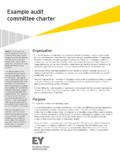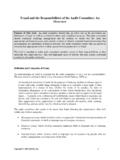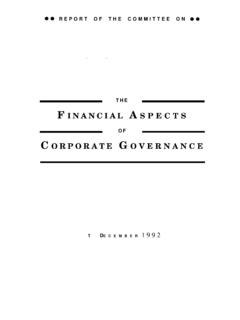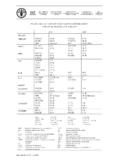Transcription of Global Advisory Committee on Vaccine safety …
1 Global Advisory Committee on Vaccine safety Statement on safety of HPV vaccines 17 December 2015 Since first being licensed at the beginning of 2006, more than 200 million doses of HPV vaccines have been distributed globally. The World Health Organization (WHO) recommends that HPV vaccines be introduced into national immunization programmes provided that: prevention of cervical cancer and/or other HPV-related diseases constitutes a public health priority; Vaccine introduction is programmatically feasible; sustainable financing can be secured; and the cost-effectiveness of vaccination strategies in the country or region is considered1.
2 The GACVS has systematically investigated safety concerns raised about HPV vaccines and has issued several reports in this regard2. To date, it has not found any safety issue that would alter its recommendations for the use of the Vaccine . GACVS reviewed data from a recent retrospective cohort study from the French National Agency for Medicines and Health Products safety on autoimmune conditions following HPV vaccination3. This large study of over 2 million girls showed a similar incidence in the vaccinated and unvaccinated populations for all conditions studied with the exception of Guillain-Barre syndrome where an increased risk was identified, mainly focused within 3 months after vaccination.
3 This risk in the first few months after vaccination was very small (~1 per 100,000 vaccinated children) and has not been seen in other smaller studies. Additional studies in adequately sized populations will help evaluate this finding and, if confirmed, better 1 See no. 43, 2014, PP. 465 492. 2 See 3 Agence nationale de s curit des medicaments et des produits de sant . Vaccins anti-HPV et risque de maladies autoimmunes : tude pharmaco pid miologique. 1/3 GACVS statement on safety of HPV vaccines 17 December 2015 assess the magnitude of an eventual risk. This risk small, if it exists at all needs to be seen in the context of the long-lasting cancer-prevention benefits of HPV infection.
4 As well, concerns about complex regional pain syndrome (CRPS) and postural orthostatic tachycardia syndrome (POTS) following HPV vaccination have been raised in certain geographic locations. These are both disorders of unclear and possibly heterogeneous etiology and the epidemiology of both conditions is not well characterized. CRPS is a chronic, painful condition usually affecting a single limb that typically follows an episode of trauma or immobilisation of a limb. The onset of symptoms of CRPS is difficult to define and is usually recognised among patients with continuing pain long after the trauma. POTS is characterized by an abnormally large and sustained increase in heart rate when changing from a lying down to an upright position.
5 This excessive heart rate increase is usually accompanied by a range of symptoms of orthostatic intolerance. Several clinical and epidemiological features contribute to POTS being especially challenging to study. Onset of POTS may be extremely difficult to ascertain retrospectively. POTS is probably relatively common in young adolescents, may be relatively infrequently diagnosed, and may be difficult to distinguish from the normal range of physiologic responses in this age group. Additionally, syncope is a common adverse event in response to immunization, especially among adolescents, which may lead to differential ascertainment of POTS in vaccinated and unvaccinated populations.
6 In spite of the difficulties in diagnosing or fully characterizing these syndromes, review of pre- and post-licensure data provide no evidence that these syndromes are associated with HPV vaccination. Some symptoms of CRPS and POTS also overlap with symptoms of chronic fatigue syndrome (CFS) for which a published observational study reported no association with HPV vaccines4. Although some cases of POTS reports were severe and long-lasting, the prognosis of POTS with symptomatic management is usually favourable, and symptoms in adolescents often resolve over time. Given the lack of specificity of some of the symptoms reported following HPV 4 Donegan K, Beau-Lejdstrom R, King B, et al.
7 Bivalent human papillomavirus Vaccine and the risk of fatigue syndromes in girls in the UK. Vaccine 2013; 31:4961-7. 2/3 GACVS statement on safety of HPV vaccines 17 December 2015 vaccination, clinicians are encouraged to refer severely-affected patients to physicians familiar with these syndromes for diagnosis and management. Prompt diagnosis and management by experienced clinicians may avoid harmful and unnecessary medical interventions and promote a prompt return to normal activities. The circumstances in Japan, where the occurrence of chronic pain and other symptoms in some Vaccine recipients has led to suspension of the proactive recommendation for routine use of Vaccine in the national immunization program, warrants additional comment.
8 Review of clinical data by the national expert Committee led to a conclusion that symptoms were not related to the Vaccine , but it has not been possible to reach consensus to resume HPV vaccination. As a result, young women are being left vulnerable to HPV-related cancers that otherwise could be prevented. As GACVS has noted previously, policy decisions based on weak evidence, leading to lack of use of safe and effective vaccines, can result in real harm5. Continued pharmacovigilance will be important in order to ensure that concerns related to the use of HPV vaccines can be addressed with the best possible evidence. The impact of HPV vaccines on HPV-related clinical outcomes, including precancerous lesions is well established.
9 The greatest health benefit globally is anticipated in countries without routine cervical cancer screening, where the Vaccine is yet to be introduced. Enhanced spontaneous reporting of adverse events following immunisation should be put in place to ensure that those who could benefit the most from the intervention are vaccinated with adequate safety monitoring. 5 3/3 GACVS statement on safety of HPV vaccines 17 December 2015

















